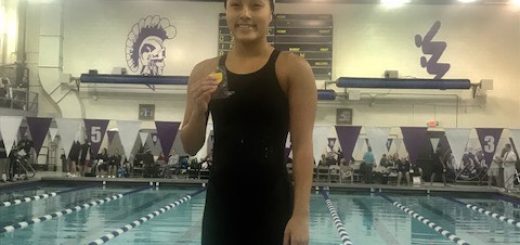Swimming in PE: Lifesaver or Time-waster?

Graphic by Eleanor Park
When the temperature outside dips below freezing, most people like to break out their snow boots and winter coats. Instead, a majority of Conant girls are unpacking their swimsuits and flip-flops. Each period of the day, girls change into their swim gear and apprehensively jump into the Conant pool. While complaining about the water temperature and their hair, they swim 30 minutes each school day for a month.
Theoretically, one might believe that swimming is an essential skill and is beneficial to all students in the long run. After all, in the case of an emergency, swimming skills could be the difference between life and death. However, Conant’s swimming units are not lifesavers. The typical sophomore girls’ swimming unit consists of snorkeling and water ballet. These activities not only inconvenience students, but they don’t make the best use of students’ time in the pool, either.
First, swimming in the middle of the day poses many obstacles and is a major issue for some students. Having to jump into a cold pool, potentially get their hair wet, and then shower during the school day throws students out of their routine. Furthermore, changing into a swimming suit in a crowded open space like locker rooms can be incredibly uncomfortable for many teens. The swimming locker rooms are much smaller than the gym locker rooms, and they force students to crowd closer together. Changing in this environment is damp, uncomfortable and generally quite dirty. Dirt is tracked in through shoes and leaves brown pools on the floor. This is unhygienic.
Additionally, coed gym classes pose problems because many students feel uncomfortable to swim in front of their opposite gendered peers. In today’s society, there is a heavy emphasis on the perfect body, which leads to inevitable body comparisons. Conant should encourage positive body images rather than putting kids in a situation where there would be criticism and judgment. Swimming requires little clothing, and it exposes insecurities for both males and females. It makes students reevaluate their self worth based on their physical features, and many students make excuses to avoid swimming for these very reasons. Schools should not encourage these kinds of lessons, especially when there are better uses for the allotted gym period.
Second, the current swimming curriculum isn’t realistically useful to students. PE teachers and aquatics directors say that the reason for incorporating snorkeling and water ballet is because they are “up-and-coming activities.” The teachers also expect that since water polo wasn’t as prominent 10 years ago, but popularized over the decade, the same could happen for water ballet. Although these are valid arguments, water ballet does not have a useful application in the future.
There are better ways to spend the 50-minute period. For example, a plausible alternative would be a self-defense class. Self-defense is a necessary and practical technique that schools should consider introducing. When students face the real world, there is a chance they won’t know how to defend themselves when faced with physical danger. Self-defense can be vital to one’s safety. Rather than learning how to handstand underwater, students can efficiently use their time by learning self-defense. Other similar PE units would prepare students for the future and equip them with a useful skill set.
Snorkeling and learning water ballet in PE makes students uncomfortable and takes up time that could be better spent learning real-world skills. It’s time to put away the snorkels and fins and listen to student voices.




Recent Comments